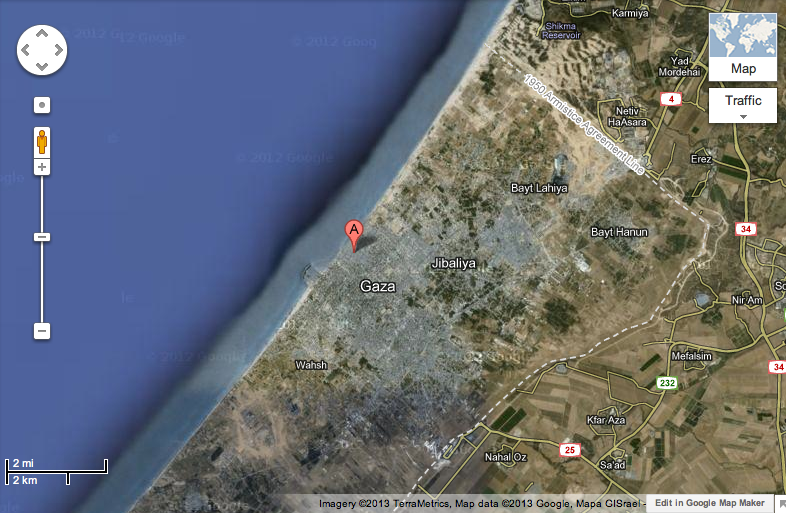
By Gal Gabriel
I have never been to Gaza, but I have always seen its sandy winds of dispute.
Gap
Gaza, the most populous Palestinian city, sits on the Mediterranean coast between Egypt and Israel in the Gaza Strip. Gazans are predominantly descendents of Palestinian refugees, who lost their homes in the1948 Arab-Israeli war. The majority live in eight refugee camps that were established by the UN Relief and Works Agency for Palestine Refugees (UNRWA). The poorest neighborhood is Ash Shati (Beach). About 87,000 people live in the 0.52 square kilometers of Shati (UNRAW, 2010). The population density is 152,631 persons per kilometer square, although the census establishes lower numbers. The population that lacks space and land ownership is growing at four percent annually. The average household size is 6.5 people (UN Habitat 2010, PCBS 2007). There are 23 schools in the camp ‘ sixteen work in double shifts. Shati is adjacent to Rimal, the most wealthy neighborhood in Gaza, and location of the Palestinian presidential palace. Ismail Haniyeh, the Gazan prime minister of the Palestinian National Authority is from Shati (BBC, 2007). Between 1967 to 2005, at the time of the Israeli occupation many of Shati’s dwellers worked as construction and agriculture laborers in Israel. However, Gaza’s economic situation has worsened since Israel placed an embargo on the strip after Hamas, considered by the US and Israel as a terror organization, took over power in 2007. As result, unemployment rate in Gaza was 45.3 percent in 2010 (UNRWA, 2011; Oxfam, 2010). Hamas bureaucracy has become the leading employment. Others work in fishery, local workshops, and sewing factories.
Coping
Shortage and pollution are major challenges of the water infrastructure in this high density neighborhood. Located downstream, Gaza relies on Israel to manage its fresh water supply. Solutions such as wastewater treatment and desalination require large investments in infrastructure and Hamas has not invested in these. Inadequate sewage system leads to ground water contamination. According to UNRWA (2010) 90 percent of the Shati’s water supply is unhealthy for human consumption (Twite, 2009; UNEP, 2009). Shati is a formal neighborhood of the Gazan municipality, but the regional dispute and distrust impede long-term planning and infrastructure provision. International aid agencies are moving to community-driven programs with community participation (World bank 2011; UNRWA 2010). For example, stormwater drainage channels are being constructed and solid waste is being collected by local dwellers who get paid by UNRWA.
Response
Due to its small area, Shati could become a pilot for low-cost, low-maintenance alternatives to conventional sewage system. Partnerships between the Islamic University of Gaza and community-based organizations could lead to the design and implementation of decentralized wastewater filtration and rainwater collection systems using the topography and household rooftops. Wastewater filtration could become a water source for non-domestic usages such as of the camp’s warehouses, thus increasing the supply of clean water for domestic usages.
References
Palestinian Central Bureau of Statistics (PCBS) http://pcbs.gov.ps/
UN Habitat statistics, 2010. Urban Indicators. http://www.unhabitat.org/stats/Default.aspx
The World Bank, West Bank Gaza – Third Additional Financing for the Second Gaza Water and Sanitation Project, 2011/03/15
UNRWA Statistics 2010, November 2011.
Weinthal, E; Vengosh, A; Marei, A; Gutierrez, A; Kloppmann, W. Sep/Oct 2005,
The Water Crisis in the Gaza Strip: Prospects for Resolution, Ground Water 43(5), 653-660
OXFAM international. The Gaza Strip, A Humanitarian Implosion by
http://www.oxfam.org.uk/resources/downloads/oxfam_gaza_lowres.pdf
IPCRI, Israel Palestine Center for Research and Information, www.ipcri.org
BBC News, June 15 2007 http://news.bbc.co.uk/2/hi/middle_east/6754499.stm